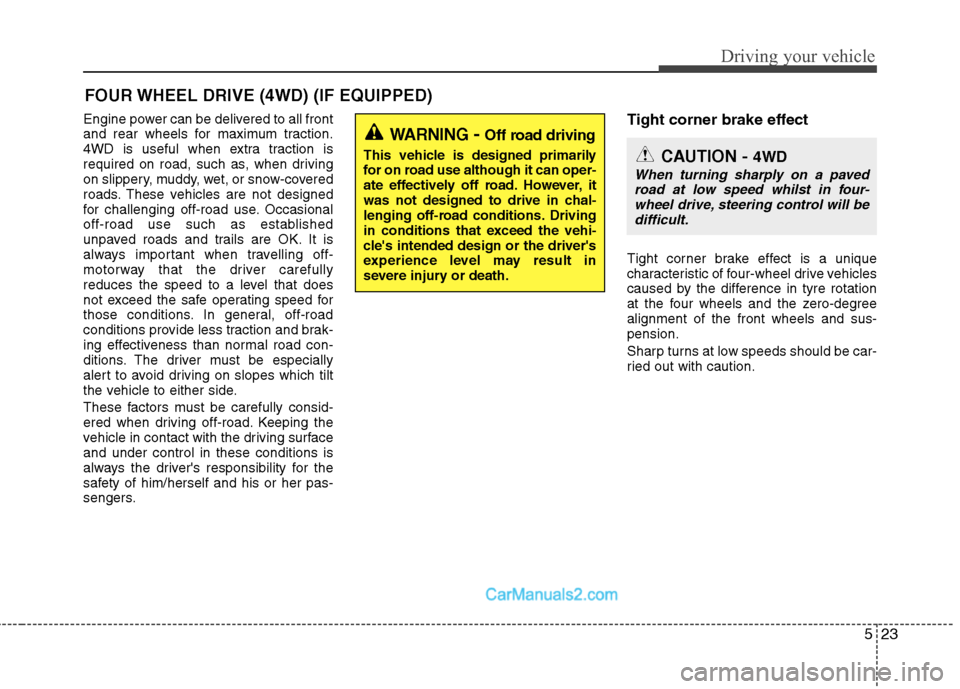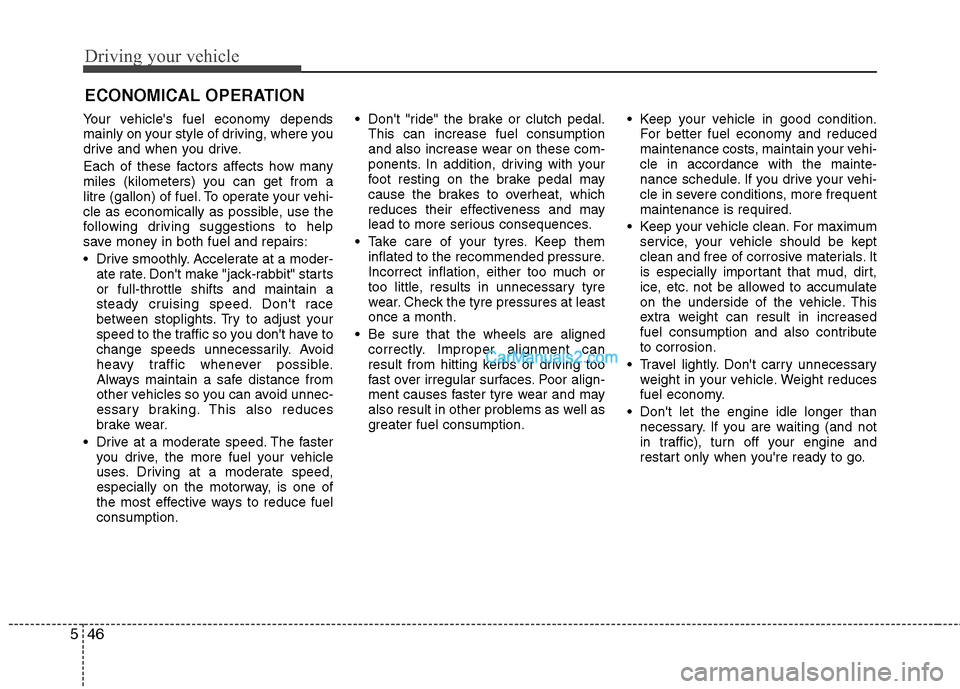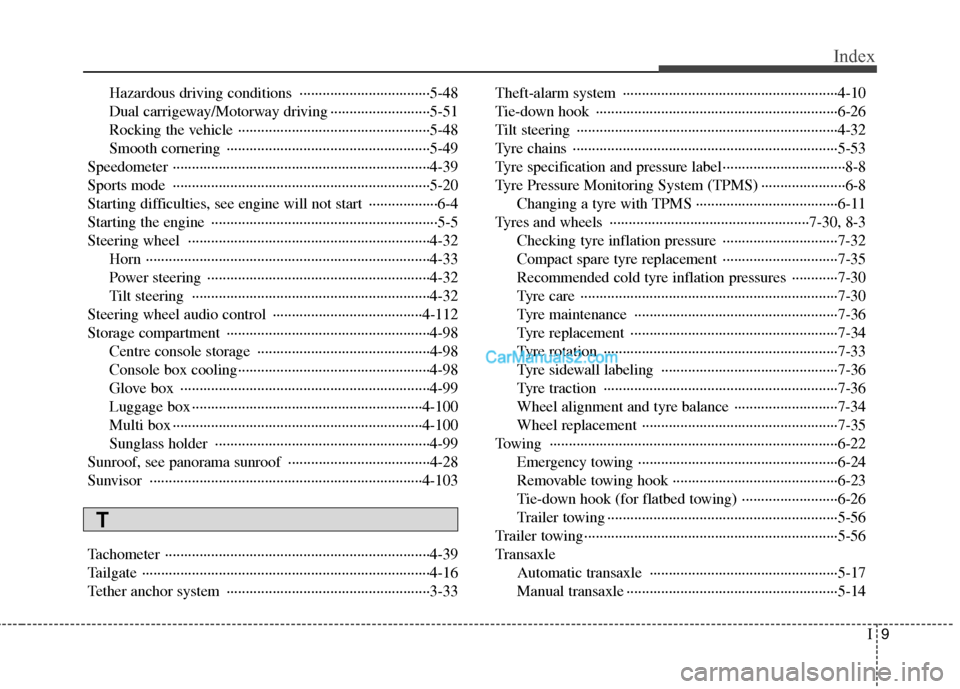2011 Hyundai Santa Fe wheel alignment
[x] Cancel search: wheel alignmentPage 226 of 312

523
Driving your vehicle
Engine power can be delivered to all front
and rear wheels for maximum traction.
4WD is useful when extra traction is
required on road, such as, when driving
on slippery, muddy, wet, or snow-covered
roads. These vehicles are not designed
for challenging off-road use. Occasional
off-road use such as established
unpaved roads and trails are OK. It is
always important when travelling off-
motorway that the driver carefully
reduces the speed to a level that does
not exceed the safe operating speed for
those conditions. In general, off-road
conditions provide less traction and brak-
ing effectiveness than normal road con-
ditions. The driver must be especially
alert to avoid driving on slopes which tilt
the vehicle to either side.
These factors must be carefully consid-
ered when driving off-road. Keeping the
vehicle in contact with the driving surfaceand under control in these conditions is
always the driver's responsibility for the
safety of him/herself and his or her pas-
sengers.Tight corner brake effect
Tight corner brake effect is a unique
characteristic of four-wheel drive vehicles
caused by the difference in tyre rotation
at the four wheels and the zero-degreealignment of the front wheels and sus-pension.
Sharp turns at low speeds should be car-
ried out with caution.
FOUR WHEEL DRIVE (4WD) (IF EQUIPPED)
WARNING
- Off road driving
This vehicle is designed primarily
for on road use although it can oper-
ate effectively off road. However, it
was not designed to drive in chal-
lenging off-road conditions. Driving
in conditions that exceed the vehi-
cle's intended design or the driver's
experience level may result in
severe injury or death.
CAUTION - 4WD
When turning sharply on a paved
road at low speed whilst in four-wheel drive, steering control will be difficult.
Page 249 of 312

Driving your vehicle
46
5
Your vehicle's fuel economy depends
mainly on your style of driving, where you
drive and when you drive.
Each of these factors affects how many
miles (kilometers) you can get from a
litre (gallon) of fuel. To operate your vehi-
cle as economically as possible, use the
following driving suggestions to help
save money in both fuel and repairs:
Drive smoothly. Accelerate at a moder-
ate rate. Don't make "jack-rabbit" starts or full-throttle shifts and maintain a
steady cruising speed. Don't race
between stoplights. Try to adjust your
speed to the traffic so you don't have to
change speeds unnecessarily. Avoid
heavy traffic whenever possible.
Always maintain a safe distance from
other vehicles so you can avoid unnec-
essary braking. This also reduces
brake wear.
Drive at a moderate speed. The faster you drive, the more fuel your vehicle
uses. Driving at a moderate speed,
especially on the motorway, is one of
the most effective ways to reduce fuelconsumption. Don't "ride" the brake or clutch pedal.
This can increase fuel consumption
and also increase wear on these com-
ponents. In addition, driving with your
foot resting on the brake pedal may
cause the brakes to overheat, which
reduces their effectiveness and may
lead to more serious consequences.
Take care of your tyres. Keep them inflated to the recommended pressure.
Incorrect inflation, either too much or
too little, results in unnecessary tyre
wear. Check the tyre pressures at leastonce a month.
Be sure that the wheels are aligned correctly. Improper alignment can
result from hitting kerbs or driving too
fast over irregular surfaces. Poor align-
ment causes faster tyre wear and may
also result in other problems as well as
greater fuel consumption. Keep your vehicle in good condition.
For better fuel economy and reduced
maintenance costs, maintain your vehi-cle in accordance with the mainte-
nance schedule. If you drive your vehi-
cle in severe conditions, more frequentmaintenance is required.
Keep your vehicle clean. For maximum service, your vehicle should be kept
clean and free of corrosive materials. It
is especially important that mud, dirt,
ice, etc. not be allowed to accumulate
on the underside of the vehicle. This
extra weight can result in increased
fuel consumption and also contributeto corrosion.
Travel lightly. Don't carry unnecessary weight in your vehicle. Weight reduces
fuel economy.
Don't let the engine idle longer than necessary. If you are waiting (and not
in traffic), turn off your engine and
restart only when you're ready to go.
ECONOMICAL OPERATION
Page 311 of 312

I9
Index
Hazardous driving conditions ··································5-48
Dual carrigeway/Motorway driving ··························5-51
Rocking the vehicle ··················································5-48
Smooth cornering ·····················································5-49
Speedometer ···································································4-39
Sports mode ···································································5-20
Starting difficulties, see engine will not start ··················6-4
Starting the engine ···························································5-5
Steering wheel ·······························································4-32 Horn ··········································································4-33
Power steering ··························································4-32
Tilt steering ······························································4-32
Steering wheel audio control ·······································4-112
Storage compartment ·····················································4-98 Centre console storage ·············································4-98
Console box cooling··················································4-98
Glove box ·································································4-99
Luggage box ····························································4-100
Multi box ·································································4-100
Sunglass holder ························································4-99
Sunroof, see panorama sunroof ·····································4-28
Sunvisor ·······································································4-103
Tachometer ·····································································4-39
Tailgate ···········································································4-16
Tether anchor system ·····················································3-33 Theft-alarm system ························································4-10
Tie-down hook ·······························································6-26
Tilt steering ····································································4-32
Tyre chains ·····································································5-53
Tyre specification and pressure label································8-8
Tyre Pressure Monitoring System (TPMS) ······················6-8
Changing a tyre with TPMS ·····································6-11
Tyres and wheels ····················································7-30, 8-3 Checking tyre inflation pressure ······························7-32
Compact spare tyre replacement ······························7-35
Recommended cold tyre inflation pressures ············7-30
Tyre care ···································································7-30
Tyre maintenance ·····················································7-36
Tyre replacement ······················································7-34
Tyre rotation ·····························································7-33
Tyre sidewall labeling ··············································7-36
Tyre traction ·····························································7-36
Wheel alignment and tyre balance ···························7-34
Wheel replacement ···················································7-35
Towing ···········································································6-22 Emergency towing ····················································6-24
Removable towing hook ···········································6-23
Tie-down hook (for flatbed towing) ·························6-26
Trailer towing ····························································5-56
Trailer towing··································································5-56
Transaxle Automatic transaxle ·················································5-17
Manual transaxle ·······················································5-14
T
Page 312 of 312

Index
10
I
Tripmeter ········································································4-42
Trip computer ································································4-43
Turn signal light bulb replacement ································7-55
Vehicle certification label ················································8-7
Vehicle identification number (VIN) ·······························8-7
Vehicle run-in process ·····················································1-5
Vehicle weight ·······························································5-65
GAW (Gross axle weight) ········································5-65
GAWR (Gross axle weight rating) ···························5-65
GVW (Gross vehicle weight) ···································5-65
GVWR (Gross vehicle weight rating) ·····················5-65
Payload ······································································5-65
Vehicle kerb weight ···················································5-65
Washer fluid ···································································7-18
Waste tray, see ashtray ·················································4-101
Warnings and indicators ················································4-46
Weight ············································································5-65 GAW (Gross axle weight) ········································5-65
GAWR (Gross axle weight rating) ···························5-65
GVW (Gross vehicle weight) ···································5-65
GVWR (Gross vehicle weight rating) ·····················5-65
Payload ······································································5-65 Vehicle kerb weight ···················································5-65
Wheel alignment and tyre balance ································7-34
Wheel replacement ························································7-35
Windows ········································································4-18 Auto up/down window ·············································4-20
Power window lock button ·······································4-21
Windscreen defrosting and defogging ···························4-95 Defogging logic ························································4-97
Winter driving ································································5-52 Snow tyres ································································5-52
Tyre chains ·······························································5-53
Wiper blades ··································································7-24
Wipers and washers ·······················································4-70
V
W